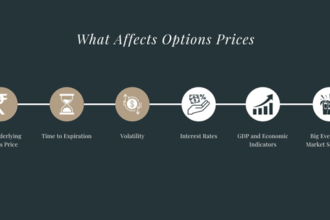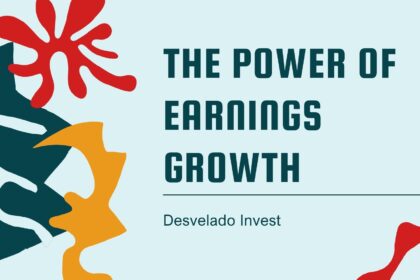Written By: Eklavya Guneja
Hello there! In this blog, we’ll break down how the price of options is decided and what makes them go up or down.
The Basics of Options Pricing
An option’s price, also known as its premium, is the cost of owning that option contract. This premium depends on several things, much like how the cost of vegetables at your local market depends on the season, the weather, and how far the farm is. For options, the factors are a bit different, but the idea is the same – various conditions come together to affect the price.
The price of an option isn’t magic. It’s a mix of:
The actual value right now (if any – also known as Intrinsic value)
The extra value due to future possibilities (like hope, fear, or expectations – also known as Extrinsic value)
Factors That Affect the Price of Options
1. The Underlying Stock’s Price
This is the biggest factor. The option is based on a stock (like Reliance, TCS, or Infosys), and if that stock’s price moves, the option’s price usually moves too.
Example:
If Rohan buys a call option (the right to buy shares later) for HDFC Bank, and HDFC Bank’s share price shoots up, the option becomes more valuable because the contracts hold more value now.
2. Time to Expiration
Options have a fixed expiry date. The more time left, the more chances the stock price can move in your favor, so the option costs more.
Think About It:
Let’s say Reliance Industries is currently trading at ₹2,500, and you buy a call option with a strike price of ₹2,500 expiring in one month for a premium of ₹100. This option costs more because you have plenty of time for Reliance’s price to rise above ₹2,500, giving the option a higher chance of being profitable.
Now, imagine there’s only one day left before the option expires, and Reliance’s price is still at ₹2,500. The same option might now cost only ₹10 because there’s very little time left for the stock to move and create value. This drop in price reflects the loss of extra “flexibility” as the expiry date approaches – just like a last-minute train ticket that has fewer options to plan.
3. Volatility
Volatility means how wildly the stock price can swing. If a stock’s price jumps around like a cricket ball on a dusty pitch in Chennai, the option becomes more expensive because there’s a higher chance of dramatic profits (or losses).
Example:
Imagine a stock like Maruti Suzuki around the time of the Union Budget. Everyone expects big announcements. If there’s more uncertainty, the price can swing a lot, increasing the volatility and therefore increasing the option’s premium.
4. Interest Rates
Interest rates set by the Reserve Bank of India (RBI) can have a small but noticeable effect on option prices. Higher interest rates can slightly increase the cost of call options and decrease the cost of put options. While this isn’t usually huge, it’s like a pinch of masala changing the flavor of a dish – subtle but present.
5. GDP and Economic Indicators
If India’s GDP growth is strong, people are generally more confident about the economy and stocks might go up, making certain options more valuable. On the other hand, if GDP growth is weak or inflation is rising, people may get nervous and put options (the right to sell) might become more attractive as they protect against falling prices.
Imagine:
If the government announces that GDP growth is surprisingly good, companies might do well, and investors might pay more for call options hoping to profit from rising share prices. Alternatively, in uncertain times put options might get pricier as investors worry about future stock drops.
6. Big Events and Market Sentiment
Just like a big cricket match between India and Pakistan can make everyone excited (or nervous), large events can affect markets. Elections, major policy announcements, global news, and even unpredictable world events can increase volatility and shift the demand for certain options.
Understand it using a scenario:
Imagine a new technology in solar panels invented by a tiny Indian startup in Pune that suddenly makes experts believe that energy stocks will boom. No one has predicted this before. This unexpected development could cause a spike in option prices for companies related to solar energy, as traders scramble to guess how big this breakthrough might be. Such a unique event, completely off the usual radar, can temporarily shake up option premiums dramatically.
Options pricing isn’t just about numbers—it’s a reflection of market dynamics and sentiment. Time to expiration, volatility, and market movements all tell a story. Each option is a clue, helping you navigate risks and opportunities.
Think of trading as solving a puzzle. Every trade sharpens your skills, turning complexity into clarity. Embrace the learning process and let the market guide you to smarter decisions.
Happy learning, and here’s to making finance-friendly and approachable!






